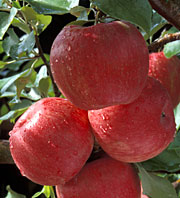Looking for the Next Best Apple
Desiree Cooper
Marc Sanchez
MAY 24, 2008
- Honeycrisp ripen apples on the tree
- (University of Minnesota)
Web Resources
More From Desiree Cooper
More From Marc Sanchez
Researchers at the University of Minnesota have been breeding apples for 100 years, and developed the Honeycrisp variety a little more than 30 years ago. In the past three years, the public has taken notice -- Honeycrisps are now a growing consumer favorite.
The patent on this apple expires this fall. That means a big loss of income. So this weekend, the university's apple breeders, like David Bedford, are busy cross-pollinating trees. They're trying to come up with the next Honeycrisp. We asked Bedford what he looks for in an apple:
David Bedford: In our breeding program, there are two things we're most concerned about: texture and flavor. In my mind, that's what really separates good apples from the world of mediocre apples, which there are plenty of out there.
Desiree Cooper: What makes Honeycrisp apples so good?
Basically, crispness. When you bite into it, you get what we call explosively crisp. And really, to get the best sensation of a Honeycrisp, you need to bite into an intact apple. Now this apple I'm going to give you is seven months old so there's not too many apples I feel...
But it looks beautiful. The color is gorgeous and it doesn't look all dimply like apples start to look when they get older.
Yep. That's true. It does have a good appearance. Although, I have to say that I've been fooled by apples in the grocery store that look pretty good but they don't have much inside.
So what are the chances that this isn't going to taste that good?
Well, I think it's pretty good. Considering its age, I think you'll be impressed.
(Bites) Mmm. Did you bring an extra napkin?
I always say it's best to eat a Honeycrisp with a bib on. It's so juicy that you're going to have some drippage almost certainly.
Well, it's actually quenching and it's sweet.
And that's another thing we look for in an apple -- we want it to have a combination of sweet and tart.
So you've already created the perfect apple. So what are you doing now during breeding season?
I can't take all the credit for Honeycrisp, by any means. I'm just sort of part of the team that has been working for a 100 years, actually, at the University of Minnesota on apple breeding. But what we're doing right now are the early stages of making crosses for this year. And crosses basically involve taking the pollen from one variety and putting it on the flower of another. You know, when you find those good ones, you say, "Oh, I think this one really does have potential to be a Honeycrisp type." Then you hold your breath.
So can you take me to your secret garden where the apples are being cultivated?
Well, I think we could... I might have to blindfold you and spin you around a few times, but yeah, we can do that.
Woah, it's windy out on this hill.
Yeah. This is sort of what we deal with in spring in Minnesota. And it doesn't make breeding always easiest, but it's not the worst of all our problems. Now the tree we're coming up to is actually our oldest Honeycrisp tree. It's not the original tree. The original tree is gone now, but this is the first tree propagated from the original, so it's over 30 years old.
So have you propagated it so that the blood will live on, so to speak?
Yep. In fact, all the Honeycrisp trees in the country, in the world right now, started from this tree.
So how do you keep the bees from pollinating the flowers when they bloom?
Yeah, that's a good question. In fact, without bees, we wouldn't have apples in most cases. So we definitely need that pollination. But of course, bees have no idea what pollen they're bringing with them. So in our case, when we want controlled pollination, we put a little wax bag -- it sort of reminds me of an old bakery bag that you get French loaves in or something. You put it on over the top, fold it a couple times in our special fold here, and put a staple at the end of it -- like that. In a week or so, when the blossoms have opened, we'll come back and take that off, we'll apply the pollen onto the flowers. And we found the best way to apply the pollen is just with the tip of our fingers.
This seems amazingly low-tech, this whole thing...
You're right. We're basically doing what the bees have done for thousands of years. The only difference is, we choose what pollen we use.
Well, David, thank you for the tour.
My pleasure.







Comments
Comment | Refresh
Post a Comment: Please be civil, brief and relevant.
Email addresses are never displayed, but they are required to confirm your comments. All comments are moderated. Weekend America reserves the right to edit any comments on this site and to read them on the air if they are extra-interesting. Please read the Comment Guidelines before posting.
You must be 13 or over to submit information to American Public Media. The information entered into this form will not be used to send unsolicited email and will not be sold to a third party. For more information see Terms and Conditions and Privacy Policy.